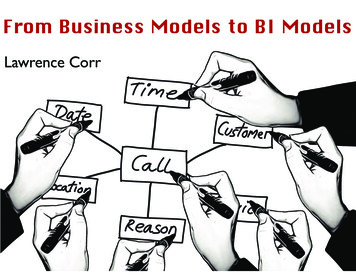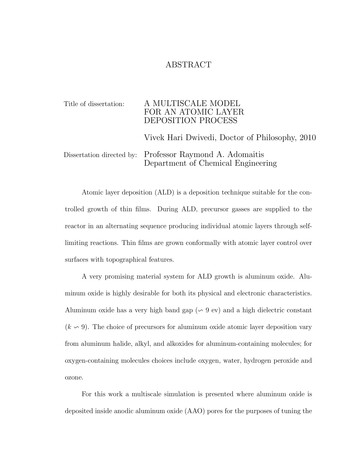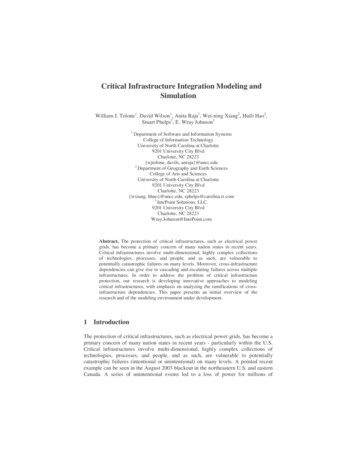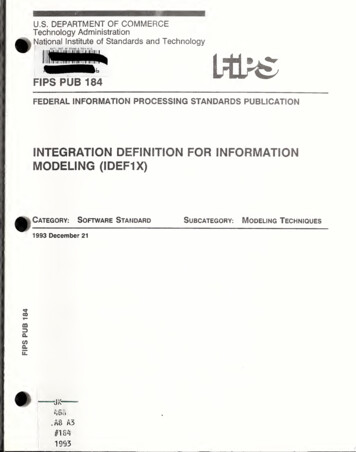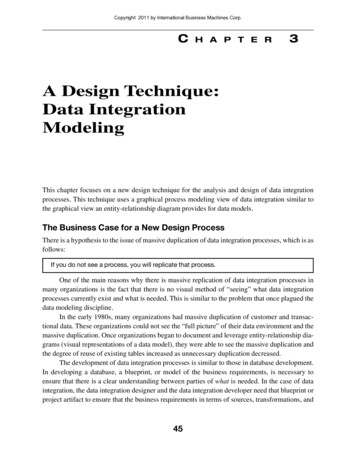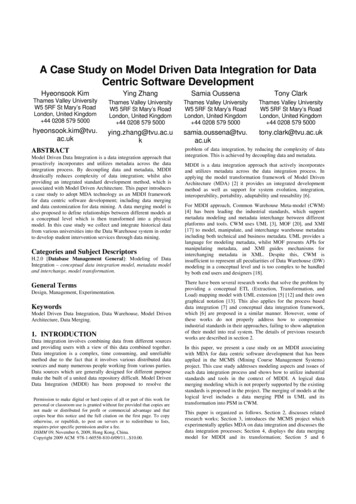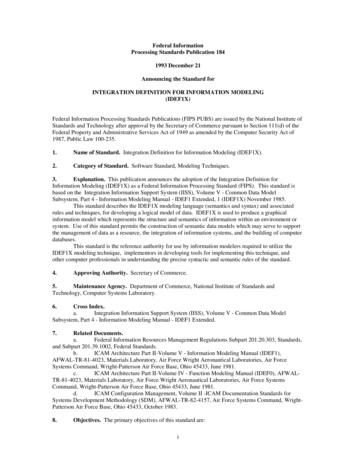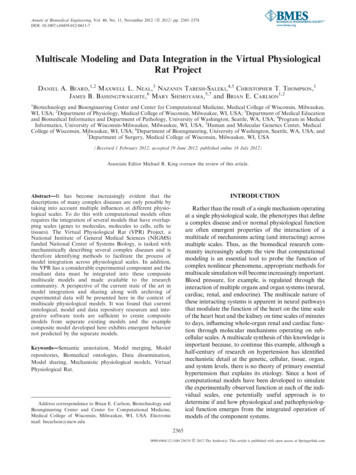
Transcription
Annals of Biomedical Engineering, Vol. 40, No. 11, November 2012 (Ó 2012) pp. 2365–2378DOI: 10.1007/s10439-012-0611-7Multiscale Modeling and Data Integration in the Virtual PhysiologicalRat ProjectDANIEL A. BEARD,1,2 MAXWELL L. NEAL,3 NAZANIN TABESH-SALEKI,4,5 CHRISTOPHER T. THOMPSON,1JAMES B. BASSINGTWAIGHTE,6 MARY SHIMOYAMA,5,7 and BRIAN E. CARLSON1,21Biotechnology and Bioengineering Center and Center for Computational Medicine, Medical College of Wisconsin, Milwaukee,WI, USA; 2Department of Physiology, Medical College of Wisconsin, Milwaukee, WI, USA; 3Department of Medical Educationand Biomedical Informatics and Department of Pathology, University of Washington, Seattle, WA, USA; 4Program in MedicalInformatics, University of Wisconsin-Milwaukee, Milwaukee, WI, USA; 5Human and Molecular Genetics Center, MedicalCollege of Wisconsin, Milwaukee, WI, USA; 6Department of Bioengineering, University of Washington, Seattle, WA, USA; and7Department of Surgery, Medical College of Wisconsin, Milwaukee, WI, USA(Received 1 February 2012; accepted 19 June 2012; published online 18 July 2012)Associate Editor Michael R. King oversaw the review of this article.INTRODUCTIONAbstract—It has become increasingly evident that thedescriptions of many complex diseases are only possible bytaking into account multiple influences at different physiological scales. To do this with computational models oftenrequires the integration of several models that have overlapping scales (genes to molecules, molecules to cells, cells totissues). The Virtual Physiological Rat (VPR) Project, aNational Institute of General Medical Sciences (NIGMS)funded National Center of Systems Biology, is tasked withmechanistically describing several complex diseases and istherefore identifying methods to facilitate the process ofmodel integration across physiological scales. In addition,the VPR has a considerable experimental component and theresultant data must be integrated into these compositemultiscale models and made available to the researchcommunity. A perspective of the current state of the art inmodel integration and sharing along with archiving ofexperimental data will be presented here in the context ofmultiscale physiological models. It was found that currentontological, model and data repository resources and integrative software tools are sufficient to create compositemodels from separate existing models and the examplecomposite model developed here exhibits emergent behaviornot predicted by the separate models.Rather than the result of a single mechanism operatingat a single physiological scale, the phenotypes that definea complex disease and/or normal physiological functionare often emergent properties of the interaction of amultitude of mechanisms acting (and interacting) acrossmultiple scales. Thus, as the biomedical research community increasingly adopts the view that computationalmodeling is an essential tool to probe the function ofcomplex nonlinear phenomena, appropriate methods formultiscale simulation will become increasingly important.Blood pressure, for example, is regulated through theinteraction of multiple organs and organ systems (neural,cardiac, renal, and endocrine). The multiscale nature ofthese interacting systems is apparent in neural pathwaysthat modulate the function of the heart on the time scaleof the heart beat and the kidney on time scales of minutesto days, influencing whole-organ renal and cardiac function through molecular mechanisms operating on subcellular scales. A multiscale synthesis of this knowledge isimportant because, to continue this example, although ahalf-century of research on hypertension has identifiedmechanistic detail at the genetic, cellular, tissue, organ,and system levels, there is no theory of primary essentialhypertension that explains its etiology. Since a host ofcomputational models have been developed to simulatethe experimentally observed function at each of the individual scales, one potentially useful approach is todetermine if and how physiological and pathophysiological function emerges from the integrated operation ofmodels of the component systems.Keywords—Semantic annotation, Model merging, Modelrepositories, Biomedical ontologies, Data dissemination,Model sharing, Mechanistic physiological models, VirtualPhysiological Rat.Address correspondence to Brian E. Carlson, Biotechnology andBioengineering Center and Center for Computational Medicine,Medical College of Wisconsin, Milwaukee, WI, USA. Electronicmail: becarlson@mcw.edu23650090-6964/12/1100-2365/0Ó 2012 The Author(s). This article is published with open access at Springerlink.com
2366BEARD et al.TABLE 1. Website links referred to in text.DescriptionSemGenJSimVPR ProjectNational Centers for System BiologyBioModels DatabaseCellML ProjectPhysiome Model ion Experiment Description MLSystems Biology Results MLNumerical MLFMAOPBEBIIMAG Data Sharing Working GroupPhysioNetVPR Model bio.org/tiki-index.php?page ibib.nih.gov/mediawiki/index.php?title Data Sharing Working Such efforts are nontrivial because manual modelintegration is highly time-consuming, prone to errorsin realizing and reproducing models, and requiresphysiological as well as computational domain expertise. To partially automate this process, we have proposed a practical workflow that makes use of tools forrepresenting and annotating models using unambiguous standards both for instantiating models and forassigning physiological meaning to model components.In addition to piloting this workflow for an examplecase, we explored how supporting data used for modelidentification and comparison can be archived inexisting repositories in a way that facilitates a transparent and unambiguous connection between modelsand data sets. The overall goal is to present a perspective of the state-of-the-art in resources for disseminating and using computational models and datain the multiscale physiology arena. In carrying out thisexercise it became apparent that, while there is nosingle standard language to convey physiologicalmeaning or to assign standardized meaning to mathematical modeling components, it is possible to knittogether a viable workflow to perform this task using asubset of existing software, standards, and databases.We found that a central tool in this process is SemGen,a software package that helps automate model annotation, composition and decomposition. SemGenleverages the semantic expressivity of the Web Ontology Language (OWL) and the mathematical generalityof JSim’s Mathematical Modeling Language (MML) togenerate semantically interoperable SemSim15,28,29 models from existing code. These models unambiguouslydeclare the physiological processes they simulate,along with the mathematical representations of thoseprocesses. SemGen and JSim are both freely availablesoftware packages. SemGen is developed by theSemantics of Biological Processes group at the University of Washington and is available on their website(SemGen, Table 1). JSim, a simulation and modelinganalysis software suite developed as part of the Physiome Project also at University of Washington and canbe downloaded from their website (JSim, Table 1).This pilot study further reveals a number of gaps in theway existing tools operate and interact that representmajor opportunities for current and future development.VIRTUAL PHYSIOLOGICAL RAT PROJECTThe Virtual Physiological Rat (VPR) project is acurrent research effort in need of more advanced modelintegration, model sharing and data sharing (VPRProject, Table 1) and is representative of similar effortsutilizing multiscale computational models to describecomplex biological processes and systems. The VPR issupported through an NIGMS National Center forSystems Biology (National Centers for System Biology, Table 1) grant to: (1) develop tools to simulate theintegrated cardiovascular function of the rat; (2)identify and validate computer models that account forgenetic variation across rat strains and physiologicalresponses to environment (i.e., diet); and (3) usethe developed models to predict the physiological
Multiscale Modeling and Data Integration in VPRcharacteristics of not-yet realized genetic combinations, derive those combinations, and then test thepredictions. Large-scale studies of the influence ofgenetic variation on cardiovascular phenotypes usingstandard statistical models reveal that identifiedgenetic determinants of complex diseases can accountfor no more than a small fraction of the total phenotype variation.3,13,22,26 On the other hand, studies ofcomplex traits in chromosome substitution (consomic)mouse and rat strains have shown that ‘‘overall phenotypic difference between the parental [strains is]much less than the sum of the phenotypic differencesattributable to individual substitutions’’.32 Resolvingthese findings (weak association with small additiveeffects from multiple loci in genome-wide associationstudies and strong super-additivity apparent in chromosome substitution studies) will require developing anew and sophisticated understanding of the linkbetween genomics and physiology. In short, the VPRproject is charged with the grand challenge of transforming our understanding of genotype-phenotyperelationships in cardiovascular physiology and diseaseby synthesizing interactions between many genes,environmental factors, and physiological systems.To make progress towards this challenge the VPRproject is specifically focusing on model developmentand identification related to cardiovascular systemdynamics; whole-body solute transport and energymetabolism; cardiac mechanics, electrophysiology, andmetabolism; renal blood flow and solute transport; andstatistical methods for mapping genetic variability tovariability in model parameters and integrated systemfunction. The goal is to account for integrative function at the subcellular to whole-body levels. Forexample, the cardiac project involves simulating subcellular biochemical processes, ion handling, excitation–contraction coupling, propagation of electricalsignal in the myocardium, and whole-organ mechanics.These processes act on time and space scales that spanseveral orders of magnitude.One of the major technical challenges facing theVPR project is the task of assembling integrativemodels from appropriate component modules. Combining computational models of interacting physiological processes in a correct and meaningful wayinvolves a synthesis and transformation of all variables, parameters, and boundary conditions in allcomponents into a new integrated model. Variablesinvoked in one model may be invoked as parameters orboundary conditions in another. For example, in therelatively simple cardiovascular system example described below, heart rate, which is a model variable inthe Bugenhagen et al.5 model of the baroreflex system,is treated as a fixed parameter in the Smith et al.34model of circulatory mechanics. Effective progress of2367the VPR project, as well as related multiscale integrative physiology research programs, will hinge on reliable archiving and annotating of computationalmodels and relevant data and automated technologyfor assembling models and associating models withavailable data.CURRENT STANDARDS FOR MODEL ANDDATA DISSEMINATION AND INTEGRATIONModel Representation StandardsAs systems-level modeling has increased in complexity over the years, researchers have recognized theneed for representation standards that enable broadmodel sharing and reuse. The Systems Biology Markup Language (SBML)20 and CellML25 are two suchstandards that have emerged over the past decade.Both are XML-based, and this declarative formatallows the model specification to exist apart from thecode-level implementation. Researchers can thereforeprocess these models in customized ways, but leave theoriginal specification intact. Using XML also providesa structure for capturing metadata about a model, suchas its provenance in the literature, curatorial information, and the biological processes it simulates. TheSBML, CellML and JSim communities have createdonline repositories (BioModels Database, CellMLProject and Physiome Model Repository, Table 1,respectively) to make models in these formats publiclyavailable, and all currently contain hundreds ofcurated models.While both SBML and CellML standards can represent the mathematics of algebraic and ordinary differential equation models regardless of biological scale,in the context of the VPR they have limited capabilitiesfor representing the biological meaning of modelcontents. SBML’s intended focus is on representing themolecular aspects of the biological processes in amodel, and the CellML standard does not yet include ametadata specification for annotating models withbiological semantics. For these reasons, the VPR isutilizing modeling languages with metadata frameworks that provide for biological annotation across themolecular, cellular, multi-cellular, tissue, organ, organsystems and population levels. Such frameworks arecrucial for a project like the VPR, where we plan tointegrate complex models across several biologicalscales. Additionally the VPR will utilize computationalmodels employing a limited class of partial differentialequations used in physiological modeling (e.g., 1-Dreaction-convection), which currently can only berepresented in an XML based format by the ExtensibleMathematical Modeling Language (XMML) used in
2368BEARD et al.JSim. SBML and CellML standards have not beenextended to represent PDEs however this functionalityis planned in the future for both standards.All three communities (SBML, CellML and JSim)have put forth considerable effort towards standardizing model annotation methods in order to facilitatemodel merging, decomposition and sharing. A complete, machine-readable description of the biologicalprocesses in a model helps automate the cumbersometask associated with model-to-model integration anddecomposition into sub-models. For example, the semanticSBML suite of tools (semanticSBML, Table 1)leverages the machine-readable reaction-level descriptions of SBML models to automate the merging ofmultiple models.23 Other model exchange and mergingsystems have been developed such as Antimony,35System for the Analysis of Biochemical PathwaysReaction Kinetics (SABIO-RK)37 and Saint24 whichfocus on SBML models or a separate reaction kinetics database in the case of SABIO-RK (Antimony,SABIO-RK and Saint, Table 1, respectively).Although this level of model interoperability is available to biochemical reaction modelers, it is not currently available to researchers who model processes atthe multicellular, tissue, organ or physiological systemslevel. To address this limitation, researchers have recently developed the SemSim modeling format, ascalable, semantics-based approach to representingbiosimulation models. SemSim leverages the knowledge in publicly available biomedical reference ontologies to thoroughly describe the biophysical meaningof a model’s contents in a machine-readable format.SemSim models contain rich, declarative semantics,implemented in OWL, and because there now exists aset of reference ontologies that describe physical entities and processes across biological scales and researchdomains, this format provides a more general solutionfor the automation of modular modeling tasks such asmerging and decomposition.Other modeling standards have been developedutilizing the markup language construct that focus onspecifying the use of these models after development.The Simulation Experiment Description MarkupLanguage (SED-ML, Table 1) has been developed toaid in the reproducibility of a simulation experimentacross different simulation environments.36 Additionally, Systems Biology Results Markup Language(SBRML, Table 1) is designed to associate simulationresults with experimental data.11 Efforts have beenmade to facilitate the exchanging and archiving ofnumerical results through the use of the NumericalMarkup Language (NuML, Table 1). All of thesestandards will be important as developed multiscalemodels are validated using multiple experimentaldatasets at multiple scales, however the current focus isto provide model identification and sharing workflowsthat will support the reuse and integration of modelsand association with new types of experimental data.Use of OntologiesThe purpose of the many biomedical referenceontologies is to define physiological, biological,chemical and physics-based entities and processes in astructured manner. Ontologies are hierarchicallystructured vocabularies of terms and relationships thatare clearly defined and designed to represent andcommunicate information about a particular scientificdomain. For the practice of multiscale physiologicalmodeling, standardizing biological information withorganized vocabularies and ontologies2,10 has provento be valuable in formally defining components ofmodels and representations of complex systems. Usingontologies allows unambiguous, systematic descriptions of biological entities, processes, and their interrelations.10 For example, Gene Ontology (GO)describes gene function through properties of proteinsand includes hierarchical information in the three domains of cellular location, molecular functions, andbiological processes.1,19 Key elements in annotatingmultiscale physiological models with ontology termsinclude: associating codewords in the model withappropriate unambiguous identifiers; specifying components and subcomponents in the model utilizing thehierarchical structure within an ontology; and linkingthe model and its components and subcomponents tosupporting measured experimental data. Describingmultiscale processes in mouse development mathematical models using a combination of GO and CellType Ontology (CL) terms has been shown to beextremely effective to provide clear definitions offunction and to allow comparison of function underdifferent conditions. This approach shows the potential application of biological ontologies to describecomplex processes and systems.1 Additionally, the useof multiple ontologies for defining components andsubcomponents of multiscale physiological systemmodels will allow them to be compared and integratedto form composite models in an automated manner.Two other ontologies that are valuable for identifying multiscale models and are widely used are theFoundational Model of Anatomy (FMA) Ontologyand the Ontology of Physics for Biology (OPB).The FMA31 provides a hierarchical, structured knowledge base of human anatomy that can be investigatedin a human readable form but can be interpretable bymachine-based applications. The Foundational ModelExplorer (FME) web-browsing tool facilitates navigation through the FMA Ontology. The FMA is continuously evolving and is supported by a multidisciplinary
Multiscale Modeling and Data Integration in VPRgroup at the University of Washington (FMA,Table 1). The OPB8 has also been developed at theUniversity of Washington and provides a rich structureof biophysical properties and processes in an ontological framework (OPB, Table 1). Thus, the OPB is acritical resource for adding semantic detail to physiological models and experimental data. As part of theSemSim framework, the FMA and OPB have beenused together to establish composite annotation termsfor computational model components that cannot bedefined using any single ontology term.9 These twoontologies along with GO are the main ontologies usedwhile performing annotation and merging tasks todevelop the multiscale computational models describedhere.Another important ontology for the systems biologycommunity is the Systems Biology Ontology (SBO)that contains seven sets of orthogonal identifiers usedto specify the physiology and mathematics of a system.10 SBO is supported by the European Bioinformatics Institute (EBI, Table 1) and is a consensusontological framework that has been developed toidentify and annotate model components includingcomponent types, component roles, physical entitiesand their associated mathematical expressions. However, the current focus of the SBO is on chemicalreaction systems and does not currently provide thebroad scope required in identifying multiscale modelsthat is facilitated by the combination of the GO, FMAand OPB.Ontologies are also currently being used and furtherdeveloped to attach semantic detail to the simulationmethods and the numerical results of simulationmodels. The ontology of simulation procedures knownas the Kinetic Simulation Algorithm Ontology(KiSAO) attaches precise identification of individualsimulation methodology steps within the model. TheTerminology for the Description of Dynamics (TEDDY) has been developed to describe the form of thesimulation results, which then can be used to identifyexperimental results in the validation step of themodel. Both of these ontologies will be valuable futurecomponents aimed at facilitating the experimentalsimulation iterative process of scientific discovery10used by the VPR Project.Data Management and DisseminationOne of the key annotation elements described aboveis the linking of pertinent experimental data to thewhole model and/or components and subcomponentsof the model. Standardization of data formats, structural elements and their attributes facilitates integration of different models and provide structures onwhich innovative analysis, and presentation tools can2369be built and experimental and computation modeldesign can be reevaluated. Moreover, formalizingmodels using guidelines on how to encode information,and standardizing data through the use of ontologyterms will enable unambiguous transfer and interpretation of the information and data.4,16 This issue ofdata sharing and management is a current workinggroup topic under the Interagency Model and AnalysisGroup (IMAG), an interagency consortium workingon several projects involved with multiscale modelingand dissemination (IMAG Data Sharing WorkingGroup, Table 1).To this end, the development of feasible dissemination platforms and standardized data-management systems are currently being proposed. Ghosh et al.16 focuseson two core aspects of management standards besidesthe use of ontologies, including minimum informationand file formats. Minimum information is defined as theleast amount of metadata to allow duplication of anexperiment. File format standards such as XML definehow the minimum information should be stored so thatit can be easily processed by a machine.16 Such measuresallow us to develop and facilitate an in depthunderstanding of physiological models and make themavailable to different research communities.A current data management system is PhysioNet, aresource for complex physiologic signals, time series,images, and relevant open source software (PhysioNet,Table 1). PhysioNet is a multicenter collaboration17funded by the National Institute of Biomedical Imaging and Bioengineering (NIBIB) and the NIGMS. Onemajor component of PhysioNet is PhysioBank, whichis an archive of physiologic signals, time series, andrelated clinical data. ‘‘PhysioBank functions as arepository for selected physiologic signals and timeseries data from published studies in peer-reviewedjournals’’.27 Datasets from PhysioBank can be downloaded in several different formats includingMATLAB readable .mat files, text files and an additional format readable by an open source WaveFormDataBase (WFDB) software package.Model Integration Using SemGenCurrently one of the most advanced tools for standardizing and integrating models is SemGen, aJava-based experimental application built to create,annotate, decompose, merge and encode modelsfor simulation, which is freely available (SemGen,Table 1). At the heart of the application is the SemSimarchitecture,15,28,29 a declarative model descriptionformat separate from code-level implementations usedto capture model semantics in a standardized manner.One of the advantages of SemGen is that SemSimversions can be created from any biological model that
2370BEARD et al.compiles within JSim, a freely available, general-purpose simulation environment (JSim, Table 1). Thisincludes most curated SBML and CellML models aswell as models coded in JSim’s MML. Once translatedinto the SemSim format, SemGen provides tools forapplying deep semantic annotations to the model elements. This annotation step captures the biologicalmeaning of the simulated processes in the model, and isthe key for making SemSim models modular andinteroperable. Once a SemSim model is thoroughlyannotated, a user can perform model decompositionand integration tasks at the biological level of conceptualization, rather than the code level. For example,using the Extractor tool within SemGen, a user canextract the heart component out of a larger cardiovascular model simply by selecting the heart-relatedphysical entities among the model’s annotations. Nomanual coding is required to create a compilable heartsubmodel, however, because this submodel is nowseparated from the larger system, input values must bespecified by the user for the submodel simulation torun. These unspecified inputs are readily identifiedvisually within the SemGen Extractor tool.When merging two SemSim models, SemGenexamines the points of semantic overlap between themodels in order to create a biologically consistentinterface between them. That is, if two models simulatethe same biological property using two different computational formulations, then the user must choosewhich formulation to preserve in the merged model.This resolution step creates an interface point betweenthe models, coupling them into a merged system. Forexample, if a user merges a model that simulates leftventricular contraction with a model of the aorta, andboth represent blood flow through the aortic valve,SemGen can identify this semantic overlap and promptthe user to create an appropriate interface between themodels where aortic valve flow is computed from theleft ventricle dynamics and drives flow into the aorta.In the following section we discuss a merging task weperformed with SemGen where we combined a cardiovascular system model with a baroreceptor modelto create a coupled system that includes baroreceptorfeedback control of arterial blood pressure.EXAMPLES FROM CURRENT VPR EFFORTExample 1: Cardiovascular Systems DynamicsIn a pilot project relevant to the VPR project, weassembled a composite cardiovascular dynamics modelby combining the cardiovascular dynamics model ofSmith et al.34 and the baroreflex systems model ofBugenhagen et al.5 The integrated composite model isdiagrammed in Fig. 1a. The published parameterization of the Smith et al. model represents human cardiovascular dynamics, as illustrated in Fig. 1b; theBugenhagen et al. model is parameterized based ondata from rat, as illustrated in Fig. 1c.The composite model was built by annotating theSmith et al. and Bugenhagen et al. models, primarilyusing the FMA,31 Gene Ontology2,19 and Ontology forPhysics in Biology,8 and combining the models usingSemGen. The Smith et al. model parameter valueswere adjusted to represent rat cardiovascular dynamics. The complete workflow of the merging processinvolved taking CellML versions of the baroreflexsystem and the CV dynamics model of Smith et al. andconverting them into MML versions using JSim. TheseMML versions were then loaded into SemGen andwere annotated individually to produce SemSim versions. (Whereas we used a previous SemGen versionthat requires converting SBML and CellML models toMML before they can be translated into the SemSimformat, the latest available version can convert SBMLand CellML models directly into SemSim models.) InSemGen, we merged these SemSim versions into thecomposite CV dynamics model and then encoded themodel in MML for simulation in JSim and conversionto CellML. Automatic conversion from MML toCellML for the composite model is now currentlysupported with JSim version 2.06 and later.During the merging process two points of semanticequivalency were identified and resolved within SemGen, namely the pressure in the aorta and the heartperiod, which were represented in both models. However, some additional manual modifications had to bemade to generate the version of the model that produced the Valsalva maneuver shown in this example.These changes were: addition of the Valsalva perturbation, adjustment of CV model parameters to reflectrat instead of human physiology, addition of left, rightventricular and septal wall elastance terms that arefunctions of heart rate, introduction of a more complicated expression for driving heart contraction that isa function of the changing heart period, and conversion of units of kPa in the merged model to mmHg.The identification of most of these changes is notwithin the current scope of the SemGen merging tooland represent alterations to the basic merged modelwhich was automatically generated; however, themanual conversion of kPa to mmHg could have beenavoided if compatible unit systems were used in thedevelopment of the CellML versions of the originalindividual models. The original CellML, MML andannotated SemSim versions of the individual modelsalong with annotated SemSim, MML and MATLAB(for comparison) versions of the final composite modeland a detailed descript
Multiscale Modeling and Data Integration in the Virtual Physiological Rat Project DANIEL A. BEARD, 1,2 MAXWELL L. NEAL,3 NAZANIN TABESH-SALEKI,4,5 CHRISTOPHER T. THOMPSON,1 JAMES B. BASSINGTWAIGHTE, 6 MARY SHIMOYAMA,5,7 and BRIAN E. CARLSON 1,2 1Biotechnology and Bioengineering Center and Center for Computational Medicine, Medical College of Wisconsin, Milwaukee, WI, USA; 2Department of .
